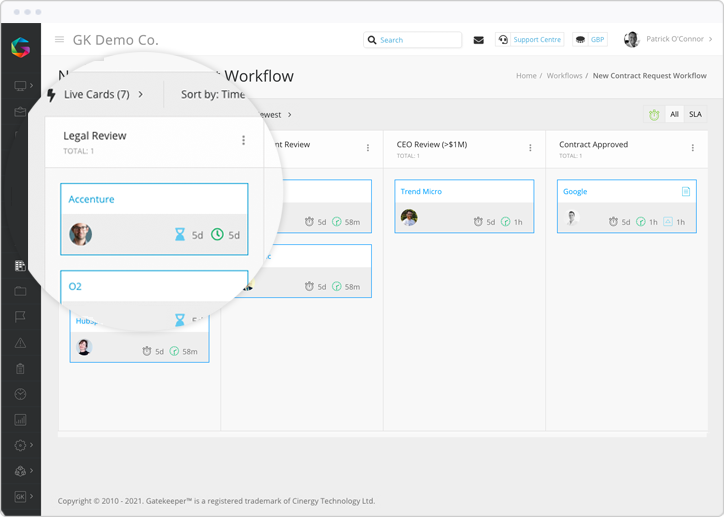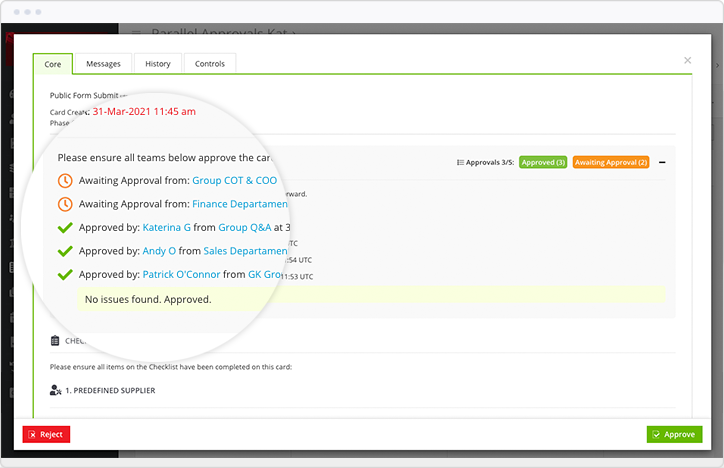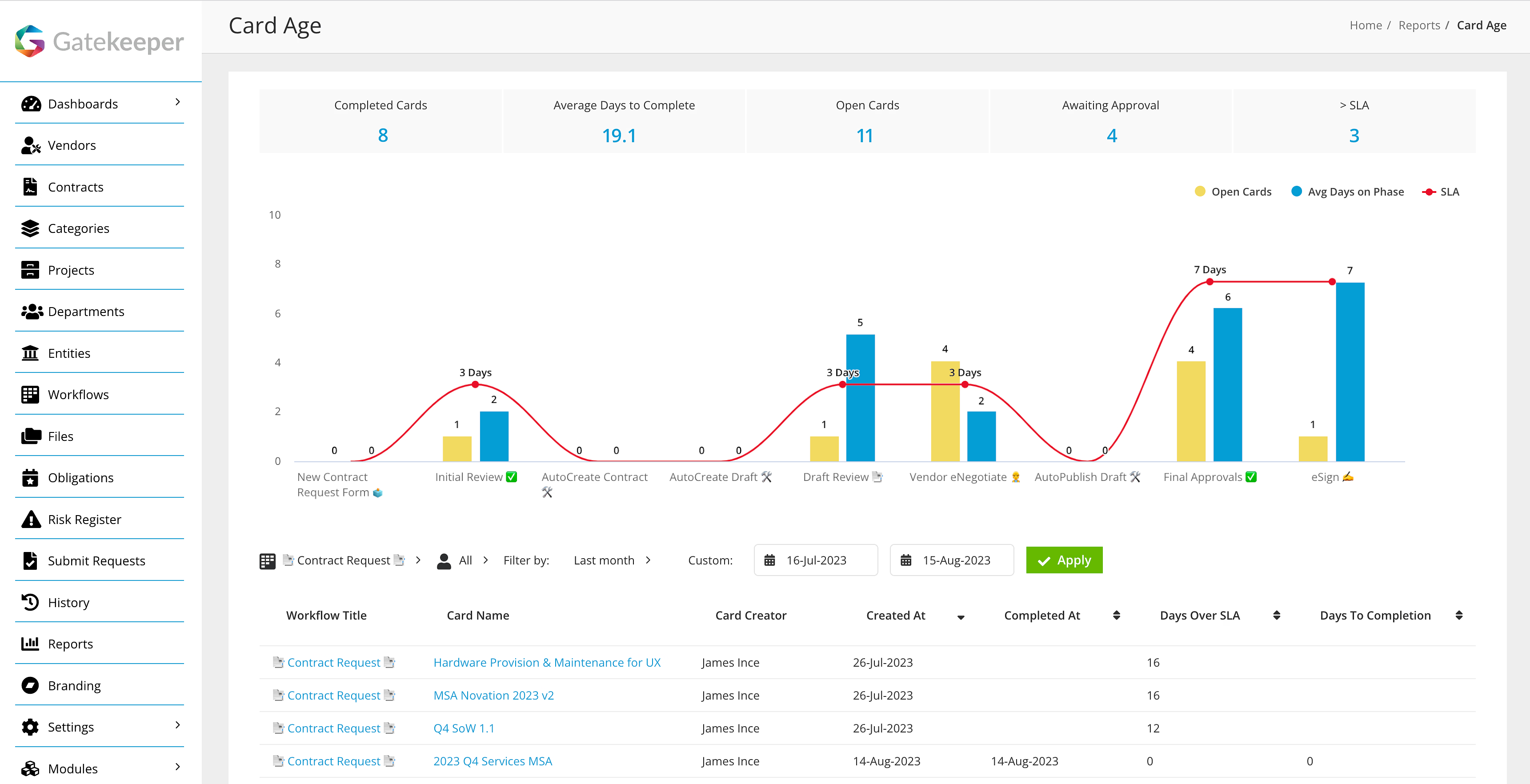How to Maximise Efficiency Through Automated Contract Workflows
10:04
Kanban, Workflows, Contract Management Software, Contract Automation, Contract Ownership, Contract Approvals, Contract Routing, Control
Shannon SmithAug 21, 2024 10:12:00 AM
Efficient contract management is vital for in-house legal teams aiming to reduce risk, maintain compliance, and accelerate business operations.
A recent report from legal talent provider, Axiom revealed that:
Automated contract workflows have never been more important for in-house legal teams expected to achieve more with less.
Let’s explore what contract workflows are, how they can be automated, and the benefits they can bring to your business.
A contract workflow is a series of steps or tasks that a contract goes through from its initiation to completion. This process typically includes drafting, reviewing, approving, executing, storing and monitoring contracts.
Each step may involve multiple stakeholders and require specific actions, such as legal reviews, financial approvals, or compliance checks.
Traditional contract workflows are often manual, involving physical documents, emails, and spreadsheets to track progress. However, these methods are prone to errors, delays, and a lack of visibility, making it difficult for legal teams to manage contracts efficiently.
Automating workflows streamlines the entire process, ensuring that contracts move smoothly from one stage to the next without unnecessary delays or mistakes.
To illustrate how contract workflows can be automated, consider a typical contract review and approval process.
In a manual setting, this process might involve multiple rounds of back-and-forth between the legal team, finance department, and executive signatories, with progress tracked through emails or shared documents.After a contract is signed, the work is far from over. Ensuring that the terms of the agreement are met, compliance is maintained, and obligations are fulfilled is crucial.
With vendor and contract management software, you can automate this process end-to-end via a contract workflow, allowing your in-house legal team to manage contracts efficiently while reducing manual effort and minimising risk.
Despite more than 71% of in-house lawyers indicating that they manage a high volume of contracts, only one in four reported that their current contract workflow technology met their needs.
Whether your business is undergoing a digital transformation process from manual approaches to dedicated contract management software, or you're looking to switch from your existing solution to a new one, there are a number of features designed to automate and enhance contract workflows.
Gatekeeper’s Workflow Engine is a powerful tool that visualises contract workflows on a Kanban board, allowing teams to see exactly where each contract is in its lifecycle. This visual representation helps to quickly identify bottlenecks and ensure that contracts move smoothly through each stage.
For example, a contract stuck in the 'Legal Review' phase is immediately visible on the Kanban board for everyone in the organisation to see. Based on Service Level Agreements, an alert can be sent prompting the legal team to take action.
This transparency and accountability reduces delays and ensures that all stakeholders are aware of their responsibilities and deadlines. The automated nature of this system means that once a task is completed, the contract automatically advances to the next stage without manual intervention.

Your business wants to operate efficiently, get value from its contracts quickly and ensure continuity. Mapping out your own processes, automating them and getting everyone on board may feel like a time-consuming task. To drive internal efficiency at a faster pace, select a solution that offers Best Practice Workflow Templates.
Implementing these contract workflow templates can significantly benefit your business by streamlining and automating critical processes, ensuring consistency, and reducing the risk of errors.
By using templates like the Touchless™ NDA Workflow, Vendor Onboarding Workflow, and Contract Renewal Review Workflow you can quickly establish efficient and standardised processes that are tailored to your specific needs. Ready-made workflows save time, reduce manual effort, and ensure that all business processes are handled in a consistent, compliant manner.
Gatekeeper supports both parallel and sequential contract approval workflows, giving legal teams the flexibility to choose the most efficient process for their needs.Parallel workflows allow multiple teams to review and approve a contract simultaneously, reducing the time it takes to move through the approval stages. This is particularly useful when a contract requires input from several departments, including Procurement and Finance.Sequential workflows ensure that a contract is reviewed in a specific order, which can be important for contracts requiring a legal review before financial approval. This feature helps to prevent bottlenecks and increase throughput.

Card Age Reporting within Gatekeeper provides insight into how long a contract has been in each stage of the workflow, based on Service Level Agreements. This feature is essential for identifying inefficiencies and delays in the contract process.
By monitoring the “age” of each contract at every stage, legal teams can make informed decisions to address bottlenecks and improve overall workflow efficiency.For example, if a contract consistently spends too much time in the review stage, it may indicate that the process needs to be streamlined or that additional resources are required. Card Age Reporting helps to ensure that contracts move through the workflow as quickly as possible, without unnecessary delays.

Automating contract workflows is essential for any in-house legal team looking to improve efficiency, reduce risk, and better support their organisation’s objectives.
Gatekeeper’s Workflow Engine offers a comprehensive solution that automates the contract lifecycle and provides the tools needed to monitor, manage, and optimise these processes.
By leveraging features such as the Kanban Workflow Engine, best practice templates, parallel and sequential approvals, and Card Age Reporting, you can transform your contract management processes.
Automated contract workflows lead to faster, more accurate, and more efficient outcomes. If you’re ready to enhance your processes, contact us today.

Shannon Smith bridges the gap between expert knowledge and practical VCLM application. Through her extensive writing, and years within the industry, she has become a trusted resource for Procurement and Legal professionals seeking to navigate the ever-changing landscape of vendor management, contract management and third-party risk management.
Sign up today to receive the latest GateKeeper content in your inbox.
.png)
.png)
.png)
-4.png)
Before Gatekeeper, our contracts
Anastasiia Sergeeva, Legal Operations Manager, BlaBlaCar
were everywhere and nowhere.
Gatekeeper is that friendly tap on the shoulder,
Donna Roccoforte, Paralegal, Hakkasan Group
to remind me what needs our attention.
Great System. Vetted over 25 other systems
Randall S. Wood, Associate Corporate Counsel, Cricut
and Gatekeeper rose to the top.
Thank you for requesting your demo.
Next Step - Book a Call
Please book a convenient time for a quick call to discuss your requirements.